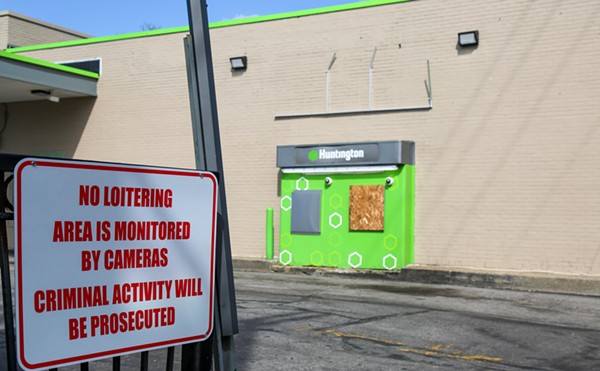Ohio Misses Out on Tens of Millions in Foreclosure Prevention Grants — Some Blame Botched Application
By Eric Sandy on Thu, Apr 21, 2016 at 10:04 am
[
{
"name": "Ad - NativeInline - Injected",
"component": "38482495",
"insertPoint": "3",
"requiredCountToDisplay": "5"
},{
"name": "Real 1 Player (r2) - Inline",
"component": "38482494",
"insertPoint": "2/3",
"requiredCountToDisplay": "9"
}
]
[image-1]One of the great debates in Ohio — and, in particular, in Cleveland — is whether neighborhood revitalization is best achieved through raising abandoned homes or rehabbing them and helping new families move into town. Thanks to the handiwork of state housing officials, the answer remains clear as mud.
Empowering and Strengthening Ohio's People (ESOP), a non-profit housing counseling agency, reports this week that the Ohio Housing Finance Agency requested $250 million from the U.S. Department of the Treasury for foreclosure prevention and demolition. Around $94 million is expected now, 38 percent of the total request.
The plan was to allocate 93 percent of that money toward demolition; the remaining seven percent would have been used more generally to prevent foreclosure across the state. (Ohio ranked in the top five states nationwide for the number of foreclosures in 2015.) Here's the issue: The U.S. Treasury Department wants this money to be spent by 2020, and officials in Washington apparently did not believe that Ohio could burn through $232 million in demolition costs in four years. Also, the Treasury Department prefers a "balanced" approach between demolition and foreclosure prevention.
Critics, including U.S. Sen. Sherrod Brown, say that the state housing agency knew those guidelines before submitting its application. “I do not know why the state made the decision to disregard Treasury’s instructions on its application and give up more than $100 million that could have supported Ohio jobs and communities,” Brown said in a statement. “I am very disappointed to see Ohio leave money on the table when so much more work needs to be done to clean up abandoned buildings and help keep people in their homes.”
Still, the $94 million is $94 million — and that will be paired with $98 million picked up earlier this year via the federal Hardest Hit Funds. (Those funds were allocated 100-percent toward demolition in Ohio.)
There's progress in the offing, to be sure. But with 200,000 vacant one- to four-unit residential properties pocking the state's neighborhoods, there's always demand for more to be done.
“To have another opportunity to take a big bite out of these problems and fumble the ball like this is just unbelievably frustrating,” Bill Faith, executive director of the Ohio Coalition on Homelessness and Housing in Ohio, told the Columbus Dispatch. “It’s so hard to find resources to help homeowners on the edge facing a foreclosure that’s unnecessary.”
Empowering and Strengthening Ohio's People (ESOP), a non-profit housing counseling agency, reports this week that the Ohio Housing Finance Agency requested $250 million from the U.S. Department of the Treasury for foreclosure prevention and demolition. Around $94 million is expected now, 38 percent of the total request.
The plan was to allocate 93 percent of that money toward demolition; the remaining seven percent would have been used more generally to prevent foreclosure across the state. (Ohio ranked in the top five states nationwide for the number of foreclosures in 2015.) Here's the issue: The U.S. Treasury Department wants this money to be spent by 2020, and officials in Washington apparently did not believe that Ohio could burn through $232 million in demolition costs in four years. Also, the Treasury Department prefers a "balanced" approach between demolition and foreclosure prevention.
Critics, including U.S. Sen. Sherrod Brown, say that the state housing agency knew those guidelines before submitting its application. “I do not know why the state made the decision to disregard Treasury’s instructions on its application and give up more than $100 million that could have supported Ohio jobs and communities,” Brown said in a statement. “I am very disappointed to see Ohio leave money on the table when so much more work needs to be done to clean up abandoned buildings and help keep people in their homes.”
Still, the $94 million is $94 million — and that will be paired with $98 million picked up earlier this year via the federal Hardest Hit Funds. (Those funds were allocated 100-percent toward demolition in Ohio.)
There's progress in the offing, to be sure. But with 200,000 vacant one- to four-unit residential properties pocking the state's neighborhoods, there's always demand for more to be done.
“To have another opportunity to take a big bite out of these problems and fumble the ball like this is just unbelievably frustrating,” Bill Faith, executive director of the Ohio Coalition on Homelessness and Housing in Ohio, told the Columbus Dispatch. “It’s so hard to find resources to help homeowners on the edge facing a foreclosure that’s unnecessary.”
SCENE Supporters make it possible to tell the Cleveland stories you won’t find elsewhere.
Become a supporter today.
About The Author
Eric Sandy
Eric Sandy is an award-winning Cleveland-based journalist. For a while, he was the managing editor of Scene. He now contributes jam band features every now and then.
Scroll to read more Cleveland News articles
Newsletters
Join Cleveland Scene Newsletters
Subscribe now to get the latest news delivered right to your inbox.













